How to Report 2024 Backdoor Roth In FreeTaxUSA (Updated)
[Updated on January 30, 2025 with screenshots from FreeTaxUSA for the 2024 tax year.]
TurboTax and H&R Block are the two major tax software for filing personal tax returns. A low-cost alternative to TurboTax and H&R Block software is FreeTaxUSA. FreeTaxUSA isn’t only for simple returns. It can still handle more complex transactions, such as the Backdoor Roth.
Just as a refresher, a Backdoor Roth involves making a non-deductible contribution to a Traditional IRA followed by converting from the Traditional IRA to a Roth IRA. Both the contribution and the conversion need to be reported in the tax software. For more information on Backdoor Roth, please read Backdoor Roth: A Complete How-To.
Table of ContentsWhat To ReportConvert From Traditional IRA to RothTraditional IRA ContributionTaxable Income from Backdoor RothTroubleshootingWhat To ReportYou report on the tax return your contribution to a Traditional IRA *for* that year, and you report the conversion to Roth *during* that year.
For example, when you are doing your tax return for year 2024, you report the contribution you made *for* 2024, whether you actually did it in 2024 or between January 1 and April 15, 2025. You also report the conversion to Roth *during* 2024, whether the contribution was made for 2024, 2023, or any previous years. Therefore a contribution made in 2025 for 2024 goes on the tax return for 2024. A conversion done during 2025 after you made a contribution for 2024 goes on the tax return for 2025.
You do yourself a big favor and avoid a lot of confusion by doing your contribution for the current year and finishing your conversion in the same year. I call this a “planned” Backdoor Roth or a “clean” Backdoor Roth — you’re doing it deliberately. Don’t wait until the following year to contribute for the previous year. Contribute for 2025 in 2025 and convert it in 2025. Contribute for 2026 in 2026 and convert it in 2026. This way everything is clean and neat.
If you are already off by one year, it depends on whether you’re handling the contribution part or the conversion part right now. If you contributed to a Traditional IRA for 2024 in 2025 or if you recharacterized a 2024 Roth contribution to Traditional in 2025, please follow Split-Year Backdoor Roth IRA in FreeTaxUSA, Year 1. If you contributed to a Traditional IRA for 2023 in 2024 or if you recharacterized a 2023 Roth contribution to Traditional in 2024 and converted in 2024, please follow Split-Year Backdoor Roth IRA in FreeTaxUSA, Year 2.
Here’s the scenario we’ll use as an example:
You contributed $7,000 to a traditional IRA in 2024 for 2024. Your income is too high to claim a deduction for the contribution. By the time you converted it to Roth IRA, also in 2024, the value grew to $7,200. You have no other traditional, SEP, or SIMPLE IRA after you converted your traditional IRA to Roth. You did not roll over any pre-tax money from a retirement plan to a traditional IRA after you completed the conversion.
If your scenario is different, you will have to make some adjustments to the screens shown here.
Before we start, suppose this is what FreeTaxUSA shows:
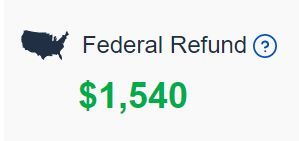
We’ll compare the results after we enter the Backdoor Roth.
Convert From Traditional IRA to RothThe tax software works on income items first. We enter the conversion first even though the conversion happened after the contribution.
When you convert from a Traditional IRA to a Roth IRA, you will receive a 1099-R form. Complete this section only if you converted *during* 2024. If you only converted in 2025, you won’t have a 1099-R until next January. Please follow Split-Year Backdoor Roth IRA in FreeTaxUSA, Year 1 now and come back next year to follow Split-Year Backdoor Roth IRA in FreeTaxUSA, Year 2. If your conversion during 2024 was against a contribution you made for 2023 or a 2023 contribution you recharacterized in 2024, please follow Split-Year Backdoor Roth IRA in FreeTaxUSA, 2nd Year.
In our example, by the time you converted, the money in the Traditional IRA had grown from $7,000 to $7,200.

Click on “Add a 1099-R” when it asks you about the 1099-R.
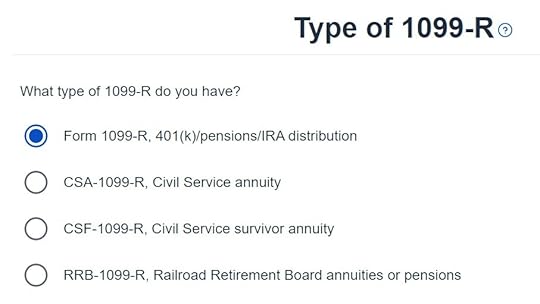
It’s just a regular 1099-R.
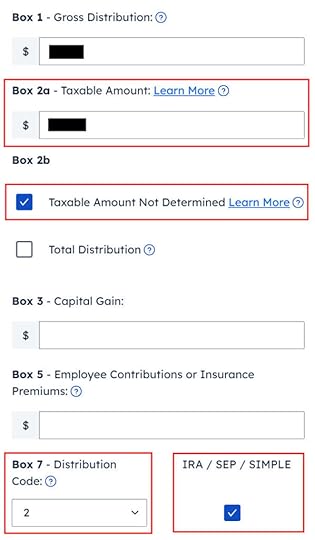
Enter the 1099-R exactly as you have it. Pay attention to the code in Box 7 and the checkboxes. It’s normal to have the same amount as the taxable amount in Box 2a, when Box 2b is checked saying “taxable amount not determined.” Pay attention to the distribution code in Box 7. It’s code 2 if you’re under 59-1/2 and code 7 if you’re over 59-1/2. The IRA/SEP/SIMPLE box is also checked.

Right after you enter the 1099-R, you will see the refund number drop. Here we went from a $1,540 refund to $264. Don’t panic. It’s normal and temporary. The refund number will come up when we finish everything.

We did not inherit this IRA.

It asks you about Roth conversion. Answer Yes to conversion and enter the converted amount.

You are done with this 1099-R. Repeat if you have another 1099-R. If you’re married and both of you did a Backdoor Roth, pay attention to whose 1099-R it is when you enter the second one. You’ll have problems if you assign both 1099-R’s to the same person when they belong to each spouse.

It asks you about the basis carried over from previous years. If you did a clean “planned” backdoor Roth every year, you can answer “No.” Answering “Yes” and entering all 0’s on the next page has the same effect as answering “No.” If you have gone back and forth before you found this guide, some of your previous answers may be stuck. Answering “Yes” here will give you a chance to review and correct them. If you have a basis carryover on line 14 of Form 8606 from your previous year’s tax return, answer Yes here and enter it on the next page.
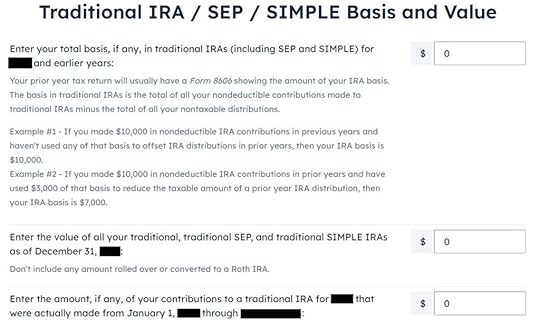
The values should be all 0 if you did a “clean” planned backdoor Roth. If you had a small amount of earnings posted to your Traditional IRA after the conversion and you didn’t convert the earnings, enter the account’s value in the second box from your year-end statement.

We didn’t take any disaster distribution.
Now continue with all other income items until you are done with income. Your refund meter is still lower than it should be but it will change soon.
Traditional IRA Contribution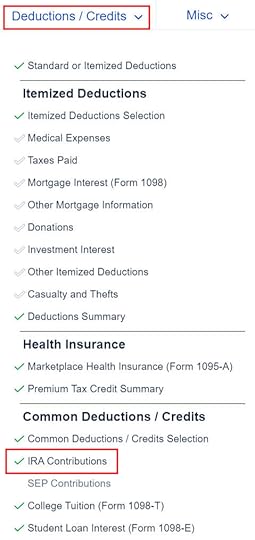
Find the IRA Contributions section under the “Deductions / Credits” menu.
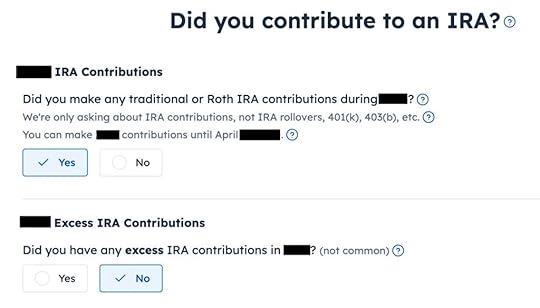
Answer Yes to the first question. An excess contribution means contributing more than you’re allowed to contribute. We didn’t have that.
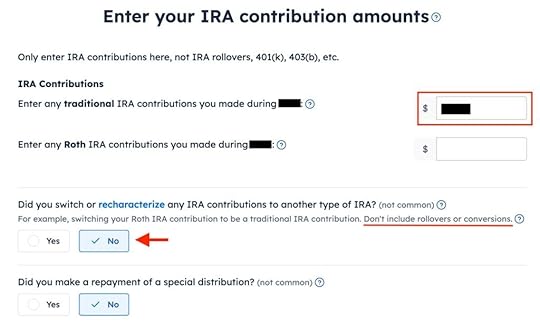
Enter the amount you contributed to the Traditional IRA in the first box. Leave the answer to “Did you switch or recharacterize” at No. We converted. We didn’t recharacterize. We didn’t repay any distribution either.
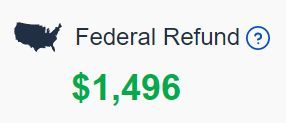
Your refund number goes up again! It was a refund of $1,540 before we started. It went down a lot and now it’s back to $1,496. The $44 difference is due to paying tax on the $200 earnings before we converted to Roth.
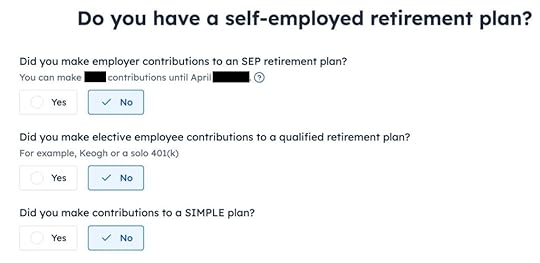
We didn’t contribute to a SEP, solo 401k, or SIMPLE plan. Answer Yes if you did.

Withdraw means pulling money out of a Traditional IRA back to your checking account. Converting to Roth is not a withdrawal. Answer ‘No‘ here.
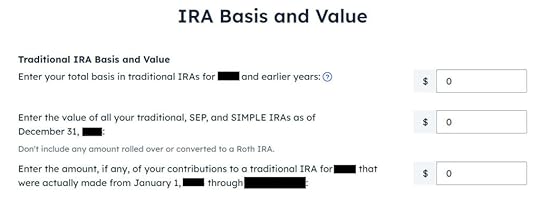
All values are zero when you did a “clean” planned Backdoor Roth. If you had a small amount of earnings posted to your Traditional IRA after you converted and you didn’t convert the earnings, enter the balance of your Traditional IRA from your year-end statement in the second box.

It tells us we don’t get a deduction because our income was too high. We know. That’s why we did the Backdoor Roth.
Taxable Income from Backdoor RothAfter going through all these, let’s confirm how you’re taxed on the Backdoor Roth. Click on the three dots on the top right above the IRA Deduction Summary and then click on “Preview Return.”

Look for Line 4 in Form 1040.

It shows $7,200 in IRA distributions in line 4a and only $200 is taxable in line 4b. If you are married filing jointly and both of you did a backdoor Roth, the numbers here will show double.
Tah-Dah! You put money into a Roth IRA through the backdoor when you aren’t eligible to contribute to it directly. You pay tax on a small amount of earnings if you waited between contributions and conversion. That’s negligible relative to the benefit of having tax-free growth on your contributions for many years.
TroubleshootingIf you followed the steps and you are not getting the expected results, here are a few things to check.
Conversion Is TaxedIf you don’t have a retirement plan at work, you have a higher income limit to take a deduction on your Traditional IRA contribution. FreeTaxUSA will give you the deduction if it sees that you qualify. It doesn’t give you the choice of making it non-deductible. You see this deduction on Schedule 1, Line 20.
Taking this deduction also makes your Roth IRA conversion taxable. The taxable Roth IRA conversion and the deduction for your Traditional IRA contribution offset each other to create a wash. This is normal and it doesn’t cause any problems when you (or your spouse) indeed don’t have a retirement plan at work.
If you actually have a retirement plan at work, the software didn’t see it. Whether you have a retirement plan at work is marked by the “Retirement plan” box in Box 13 of your W-2.
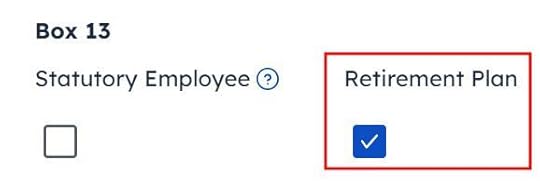
Maybe you forgot the check it when you entered the W-2. Double-check the “Retirement plan” box in Box 13 of your (and your spouse’s) W-2 entries in FreeTaxUSA to make sure they match the W-2.
Self vs SpouseIf you are married, make sure you don’t have the 1099-R and the IRA contribution mixed up between yourself and your spouse. If you inadvertently assigned two 1099-Rs to one person instead of one for you and one for your spouse, the second 1099-R will not match up with a Traditional IRA contribution made by a spouse. If you entered a 1099-R for both yourself and your spouse but you only entered one Traditional IRA contribution, you will be taxed on one 1099-R.
Learn the Nuts and Bolts I put everything I use to manage my money in a book. My Financial Toolbox guides you to a clear course of action.Read Reviews
I put everything I use to manage my money in a book. My Financial Toolbox guides you to a clear course of action.Read ReviewsThe post How to Report 2024 Backdoor Roth In FreeTaxUSA (Updated) appeared first on The Finance Buff.
Harry Sit's Blog
- Harry Sit's profile
- 1 follower



